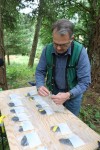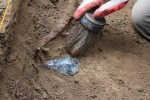 A rare cache of Native American two-faced stone tools known as bifaces has been discovered on private property in Oregon’s Willamette Valley. The landowner, who prefers to remain anonymous, discovered the obsidian pieces with the telltale flaked edges of flintknapping while digging a pond and notified the Oregon State Historic Preservation Office. Assistant State Archaeologist John Pouley excavated the find site and unearthed a total of 15 blank trade bifaces, tools shaped by flintknappers for trade but left incomplete.
A rare cache of Native American two-faced stone tools known as bifaces has been discovered on private property in Oregon’s Willamette Valley. The landowner, who prefers to remain anonymous, discovered the obsidian pieces with the telltale flaked edges of flintknapping while digging a pond and notified the Oregon State Historic Preservation Office. Assistant State Archaeologist John Pouley excavated the find site and unearthed a total of 15 blank trade bifaces, tools shaped by flintknappers for trade but left incomplete.
“For starters, we wouldn’t know the site existed if the landowner hadn’t reached out to our office to report the find,” Pouley said. “Aside from the importance of his stewardship, the biface cache is additionally a rare type of archaeological site.
“Of approximately 35,000 recorded archaeological sites in Oregon, few, likely less than 25, consist of biface caches, he added. “Of the known biface cache sites, it is believed to be the first recorded in the Willamette Valley.”
Archaeologists were able to trace the origin of the obsidian from its chemical composition to Obsidian Cliffs in the Central Oregon Cascades more than 100 miles east of the Willamette Valley. The rough shaping was done there. It’s not clear how they ended up in the valley in the traditional territory of the Santiam Band of the Kalapuya. The Confederated Tribes of the Grand Ronde, the Confederated Tribes of the Siletz and the Confederated Tribes of the Warm Springs Reservation were consulted by archaeologists during the dig for insight into the artifacts and their movements.
 Blank bifaces are rare. The vast majority discovered are finished tools — hand axes, knives, spear tips, arrowheads — stockpiled and buried. Biface caches have been found all over the world dating back as far as 20,000 years ago. Sometimes they appear as burial offerings in a funerary context. Other times they are buried in isolated locations probably for storage purposes with the intent of later retrieval. The Willamette Valley cache is of the latter type and is between 1,000 to 4,000 years old.
Blank bifaces are rare. The vast majority discovered are finished tools — hand axes, knives, spear tips, arrowheads — stockpiled and buried. Biface caches have been found all over the world dating back as far as 20,000 years ago. Sometimes they appear as burial offerings in a funerary context. Other times they are buried in isolated locations probably for storage purposes with the intent of later retrieval. The Willamette Valley cache is of the latter type and is between 1,000 to 4,000 years old.
There is no equivalent of the UK’s treasure trove law in the United States. All archaeological objects (save for Native American human remains and related funerary objects) found on private land belong to the landowners. The Oregon State Historic Preservation Office doesn’t know what the landowner plans to do with the bifaces. He can keep them, donate them to a museum or another institution or a tribe. He could sell them, for that matter, but given his responsible reporting of the find, which he was in no way legally obligated to do, perhaps he’ll take the more civic-minded approach. He already took advantage of the unique opportunity to have middle school students observe the excavation as a field trip.
The cache gave them a tangible piece of history, said a teacher who accompanied the students to the site. Adding, “When we study the history of ancient native peoples of this area, we can now speak more fully to a complexity of culture — trade routes, the manufacturing of goods, migratory patterns–and then point to artifacts like those found here and show our students the evidence.”
Pouley plans to publish a formal archaeological report in a peer-reviewed journal and he will also share his findings with those students and the rest of the pre-K through 12th grade Abiqua Academy.
You can get a glimpse of the excavation of the 15th biface in this video:
[youtube=https://youtu.be/uykpM12iSdE&w=430]
In this one Assistant State Archaeologist John Pouley discusses the biface cache:
[youtube=https://youtu.be/jkoNCyXuvZs&w=430]
In England and Wales, “Non-treasure finds remain the property of their finders or landowners, who are free to dispose of them as they wish.” So you can keep bits of stone.
But: “finders of objects that are not treasure or treasure trove are encouraged to voluntarily report them under the Portable Antiquities Scheme to finds liaison officers at county councils and local museums. Under the scheme, which started in September 1997, the officers examine finds and provide finders with information on them. They also record the finds, their functions, dates, materials and locations, and place this information into a database which can be analysed. The information on the findspots may be used to organize further research on the areas.”
ex WKPD.
Isn’t -more or less- just any blade by definition a ‘biface’ ? :confused:
Check out ‘Biface Reduction‘ by Dr. C. Clarkson and ‘Ancient Technology in Contemporary Surgery‘.
When I was very young, my uncle was always said to be a biface by most members of our family. I know exactly where he is buried, even though he was no treasure according to his widow. Oh…wait! That was “two-faced”. My mistake. Poor memory. Never mind.
😆
That’s pretty cool.
It varies from state to state, dearie. In Kentucky if it’s in or under your land you can do whatever you want with it. In Virginia, next door, you can get in trouble for picking up an arrowhead or anything else for that matter, as there’s ton of colonial, Revolutionary, and Civil War artifacts there.
There was farmer in Kentucky that had a major Ft. Ancient culture sight on his property that he sold to a group of collectors to excavate a couple of decades ago. There was nine kinds of Hell raised over it but his property rights stood.
We have an old flint quarry on our farm. Just a few locals and the State Dept. of Culture and History know about. The land is held in a permanent trust it can’t developed. There’s small Adena mound in the river bottom that we’ve had trouble with pot hunters poking around at over the years and several rock mounds on the ridges, but those things are common as dirt in the region. The odd thing is no one can really figure out what they were used for? Just a low mounds of river cobbles on the ridges throughout the region. They date to roughly the Adena-Hopewell transition but as for use it’s only speculation.
The things are are ankle breakers as their generally covered by leaves and humus. You think you’re going up a little rise in the ridge and ‘whoops’ you’re in to mid-shin and pitching forward.
There are lot of broken flints up at the quarry but they’re discards. Nothing as fine as that.